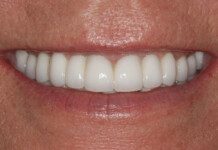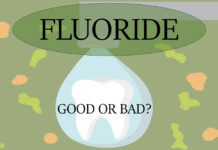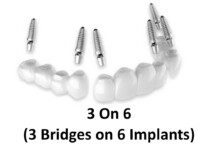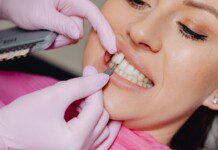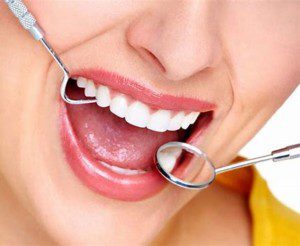
Cracked teeth can be painful, unattractive and very costly to repair. (That is, IF they’re still restorable when the crack is discovered or becomes problematic). I see cracked teeth all the time. Research suggests that the majority of adults have at least one posterior (molar or premolar) cracked tooth. Crack progression and related symptoms are a common concern in every dental practice.
ABOUT CRACKED TEETH
Cracked teeth can be caused from injury, excessive chewing forces (chewing really hard things like ice, Jolly Rancher type candies, beef jerky) or from clenching or grinding habits.
SYMPTOMS OF A CRACKED TOOTH
- Pain that comes and goes, particularly when chewing
- Sensitivity when biting or chewing
- Throbbing
- Sensitivity to temperature changes
- Sensitivity to sweets
- Swelling around the tooth
Cracked teeth can cause symptoms that range from mild sensitivity to hot and cold, to the feeling of sudden erratic, sharp pain with the release of biting force. You may also experience pain when your tooth is exposed to extreme temperatures, like ice cream or coffee. In many cases, this is difficult to diagnose, because the pain can come and go and the cracks are sometimes very hard to see, even on a regular dental x-ray. CBCT scans have a better potential to detect fractures; particularly root fractures. We have a CBCT Scan here in our office. These scans help us locate and assess tooth fractures so we can provide an accurate and prompt diagnosis.
WHAT CAUSES TEETH TO CRACK?
- Age: Many tooth cracks happen after the age of 50
- Excessive chewing forces: Biting or chewing hard foods, such as ice, hard candy, beef jerky, etc
- Habits, such as chewing ice or chewing gum
- Trauma like falls, sports injuries, accidents, physical violence
- Tooth clenching or grinding (bruxism)
- Large dental fillings weakening a tooth, leaving thinner amounts of enamel prone to fracture
- Root canals: When the nerve is removed, the blood supply is removed, weakening the teeth and they become brittle over time
WHICH TEETH ARE MORE LIKELY TO CRACK?
- Upper front teeth
- Lower back teeth
- Teeth with large restorations
WHY DOES IT HURT?
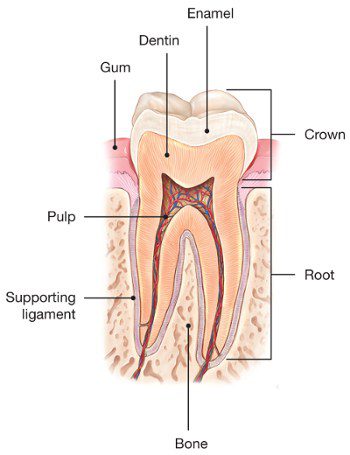 To understand why a cracked tooth hurts, it helps to know something about the anatomy of the tooth. Inside the tooth, under the white enamel and a hard layer called the dentin, is the inner soft tissue called the pulp. The pulp contains the tooth’s nerves and blood vessels.
To understand why a cracked tooth hurts, it helps to know something about the anatomy of the tooth. Inside the tooth, under the white enamel and a hard layer called the dentin, is the inner soft tissue called the pulp. The pulp contains the tooth’s nerves and blood vessels.
When the outer hard tissues of the tooth are cracked, chewing can cause movement of the pieces, and the pulp can become irritated. Eventually, the pulp will become damaged to the point that it can no longer heal itself.
Extensive cracks can lead to an abcess or other infection of the pulp tissue, which can spread to the bone and gum surrounding the tooth.
WHAT CAN BE DONE TO FIX IT?
The treatment and outcome for a cracked tooth depends on the TYPE of crack, LOCATION of the crack and the SEVERITY of the crack. This is where the training, experience and competence of the dentist diagnosing the problem is CRUCIAL: in getting the correct diagnosis! This is often something that is either misdiagnosed or not diagnosed at all. If it’s not found at all, the patient continues living with pain and not knowing which tooth is causing it.
If it is improperly diagnosed and the wrong treatment recommended, the result can be devastating: thousands of dollars spent and months of treatment (Example: Root Canal, Post & Core, Crown) that ultimately fails anywhere from a few months to a few years later. And then, if that happens, you’re looking at a dental implant and crown, and possible bone grafting, to replace it. Very costly and time consuming treatments. So, proper diagnosis and treatment is the key.
COMMON TREATMENTS FOR CRACKED TEETH CAN INCLUDE:
- Bonding: A composite resin restoration used to fill in the fracture
- Veneer: A thin porcelain facing that covers the front of the tooth. Often used when the crack is very small and not deep, and you have enough natural tooth left after removing the crack
- Crown: A porcelain crown or cap is made to be fitted over the tooth to protect it. Often done when there’s not enough solid enamel for a veneer.
- Cosmetic recontouring: Can sometimes done if the crack is extremely small and shallow, and can just be buffed off, recontouring the edges esthetically
- Root canal: Done when the fracture leads into the pulp of a tooth
- Extraction and Implant: Done when the crack involves the root and nerves of the tooth and there is severe damage
UNDERSTANDING DIFFERENT TYPES OF CRACKS AND WHY SOME CANNOT BE REPAIRED
CRAZE LINES
Craze lines are tiny little cracks you may see on teeth if you look up close up in a mirror. These are tiny cracks that are not deep and only affect the outer ENAMEL layer of the tooth. Other than possibly being concerned about the esthetics of this, these types of cracks do not cause concern and do not cause pain.
A FRACTURED CUSP
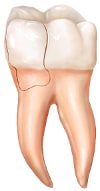 When just the cusp of a tooth cracks, it usually doesn’t cause much discomfort and can typically be repaired with either a new filling or crown, depending on the size, location and extent of the crack lines.
When just the cusp of a tooth cracks, it usually doesn’t cause much discomfort and can typically be repaired with either a new filling or crown, depending on the size, location and extent of the crack lines.
TREATABLE vs NON-TREATABLE CRACKS
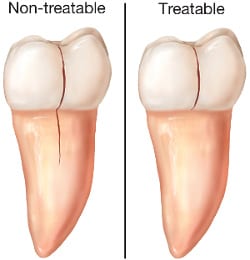 If the crack has extended into the pulp, the tooth can sometimes be treated with a Root Canal and Crown to correct the crack from spreading.
If the crack has extended into the pulp, the tooth can sometimes be treated with a Root Canal and Crown to correct the crack from spreading.
However, if the crack extends below the gum line, it is no longer treatable, and the tooth cannot be saved and will need to be extracted. That’s why early treatment is so important. A cracked tooth that is not treated will progressively worsen, eventually resulting in the loss of the tooth. Early diagnosis and treatment are essential in saving these teeth.
PREVENTING CRACKED TEETH
Here are some steps you can take to protect your teeth from cracking:
- Don’t chew on hard objects (ice, hard candy, beef jerky, popcorn kernels, pens, etc.)
- Wear an athletic mouth guard if you play contact sports
- Don’t use your teeth as a tool (to open bags, remove price tags from clothing, crack nuts, etc. Reach for the scissors or nutcracker instead.)
- Don’t grind or clench your teeth
- If you ARE someone who does this at night, speak with your dentist about having an occlusal guard/ nightguard made to wear while you sleep – and then WEAR IT!
It is imperative that cracked teeth get diagnosed as soon as symptoms appear. If it’s not, over time it can get bigger and could possibly even render the tooth non-restorable, in which case, it would need to be extracted. This is what we want to prevent. So, next time we see you, we will be checking out those teeth for any cracks!
If we’ve never seen you and you’d like to come in for an evaluation and x-rays, CONTACT US here or call us at 214-956-9100 and schedule your complimentary consultation today.

